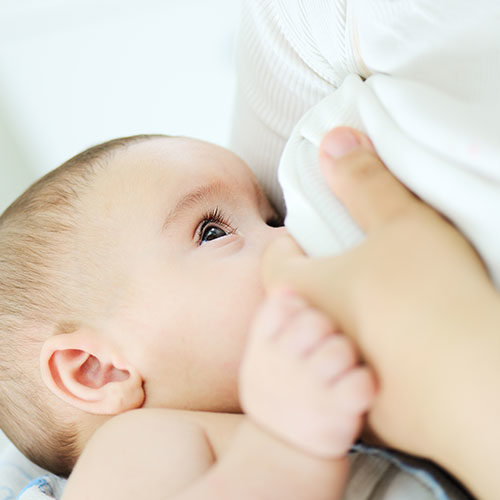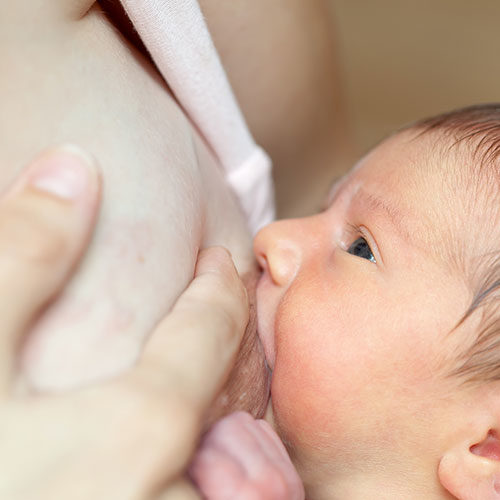Introduction of formula
Bar some uncommon and rare conditions wherein it is genuinely required; formula is often advised by medical professionals and/or well meaning family members and friends under the pretext of following reasons.
- To meet the needs of the newborn until milk comes in.
- Mother’s milk is not enough.
- To give the mother some rest.
- Until mother learns to breastfeed.
- As a solution to latching difficulties.
- As a solution to tackle lactose intolerance.
- As a solution to poor weight gain.
- When the baby is separated from the mother and is in the NICU.
- As a means for the father to bond with the baby.
- To make the baby used to the mother not being around all the time.
The list can go on. But the bottom line is that – formula is advised at the drop of a hat. And it is very easy to fall into this ‘top-up-trap’ for a new mother who is struggling to cope up with the sudden changes in her life while feeling totally exhausted, overwhelmed and vulnerable.
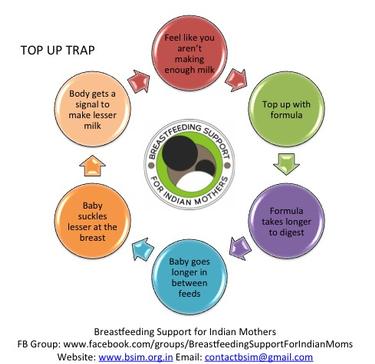
It’s called a trap because it’s a cycle that’s difficult to break once introduced. Plus, it can contribute to hampering the mother’s supply further.
After the initial 3-4 days, breast milk is produced on a demand and supply basis. The more the baby demands, the more milk the mother’s body will produce. But how is this demand conveyed to the mother’s body? By breastfeeding. When the baby suckles at her mother’s breasts, her body gets the signal to make more milk. Thus, the more the baby nurses, the more is the milk production.
Now, consider what happens when the baby is given formula :
When a baby is given even 1 feed of formula, the baby becomes full without nursing. So, the demand for breast milk that was going to be conveyed by that particular nursing session has not been conveyed to the mother. So, the production is hampered. Secondly, formula takes longer to be digested. Therefore, the baby goes longer between feeds. So, the next nursing session starts way after the expected interval. When the mother’s body doesn’t get the message to make milk for long intervals, it leads to more drop in the supply. One might think that one or two skips won’t make much difference. But they do, to a great extent. Especially when the supply is still being established. Unfortunately, the victims of the Top-up-Trap are usually new mothers who are yet to establish their supply. When they fall into this trap, their supply could diminish drastically and it might become increasingly difficult to break free from this vicious cycle.
Very Importantly seek a Lactation Professional’s help
It is possible to break free from the top-up-trap and wean the baby completely off formula. It requires a lot of determination, dedication and hard work; but it is absolutely possible and quite worth the effort.
Step 1
The first step is to determine how many times is the mother breastfeeding the baby in 24 hours? If it is any less than 10-12 times, the primary focus needs to be on increasing the frequency. This implies that every time the baby shows hunger cues, the baby needs to be breastfed. No alternate feeding of breast milk and formula. Formula is only to top up. So, whenever the baby demands, the baby must be breastfed first. Only then, the desired frequency of minimum 10-12 times in 24 hours can be reached. If the baby demands more than that, that’s ok too. And the baby must be breastfed first, every single time.
Step 2
Along with the nursing frequency, the nursing efficiency is also equally important. Baby’s latch (insert link to the latch article) should be correct in order to ensure effective milk transfer.
Step 3
Once the mother is nursing at least 10-12 times in 24 hours and the baby is nursing efficiently, the next step is to determine how much formula is consumed by the baby in 24 hours. Depending on the amount of formula consumed, one can figure out the next step. If the formula offered is very less – 60-90 ml (2-3 oz) in 24 hours, the baby can probably be brought back to breast by only increasing the frequency of nursing. But if the baby is receiving a lot of formula e.g. >150 ml ( >5 oz), then a weaning plan can be made and followed.
Step 4
When a baby is receiving a lot of formula, it cannot be stopped suddenly or reduced drastically. The process of weaning off formula needs to be gradual – reducing 30 ml to 60 ml (1 to 2 oz) formula every 3-4 days. It’s important to note that – the reduction in offerings of formula is done every 3-4 days and not every 3-4 feeds. Depending on how much formula is being consumed by the baby at the starting point of the weaning journey, it can take from a few days to several weeks to wean the baby completely off formula.
E.g. If the baby is receiving 210 ml (7 oz) formula everyday, a weaning plan for 15 days can be made. (See Table – 1 for a reference formula weaning plan)
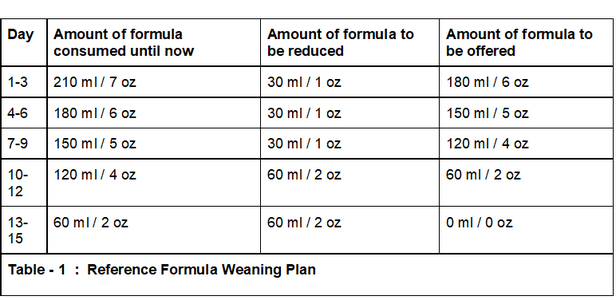
Some important things to keep in mind while implementing a weaning plan are as follows –
- As top up milk is slowly reduced, closely monitor the pee/poop count and weight gain.
- If pee/poop count and weight gain are consistent, do not exceed the (reduced) amount of formula being given to the baby in each step.
- If the baby’s pee/poop count and weight gain are dropping and are borderline or less than sufficient, spend a few more days at the same supplement level; or return to the previous supplement level and proceed at a slower pace (spend more days on each step before reducing the formula further), if needed.
Other helpful interventions that could help speed up the formula weaning process
- Skin to skin : When the baby’s body is in close contact with that of the mother, magic happens. Baby becomes more willing to latch and breastfeed actively while the mother’s body releases oxytocin that helps the let down of the milk. The breastfeeding relationship is strengthened with these mutual responses. When practiced regularly, it steadily increases the supply leading to less dependence on supplements.
- Nursing Vacation : Nursing vacation, as the term indicates, is a holiday dedicated to breastfeeding – that mother and baby take together. In a nursing vacation, mother and baby spend days and weeks together wherein they are almost inseparable. Mother keeps the baby close to her at all times and the baby is given unlimited access to the mother’s breasts. There’s plenty of skin to skin and the baby is nursed at every possible opportunity. This boosts supply to a great extent. The latch is perfected and the milk transfer becomes more efficient. Baby becomes more inclined to breastfeed and mother becomes more attuned to baby and her needs and cues. All in all, a nursing vacation has potential to help a breastfeeding relationship more than any other technique.
- Topping up with EBM : When there’s a need to top up a breastfeeding session; it can also be done with expressed breast milk (EBM). It’s a great way to limit and in later stages, to avoid formula. Breast milk can be either expressed manually through hand expression or by using a pump. When a baby is given EBM as top up, the baby needs less formula. The initial schedule in the formula weaning plan may follow the routine of [breastfeeding+EBM+formula] in each session. As the plan progresses, the amount of formula offered will come down to ‘0’, leaving the schedule to look like only [breastfeeding+EBM]. At this stage, the baby has been completely weaned off formula and still being offered EBM as top up. Now, it becomes very easy to bring the baby entirely back to breast as the body is already making enough milk for the baby.
- Pumping to stimulate supply : Pumping can serve two purposes while a mother tries to wean her baby off formula.
- i) Expresses milk which can be used to top-up a nursing session.
- ii) Stimulates the breasts and nipples, giving the body signal to produce more milk.
However, one needs to know that pumping ideally isn’t recommended in the initial 6 weeks when the supply is being established, as it can lead to oversupply. Thus, if mother and baby are not going to be separated, direct breastfeeding would be a more convenient option than pumping even when the mother is looking to increase her supply. In cases wherein the baby isn’t nursing directly and/or has developed bottle preference and the mother wishes to wean her off formula, pumping can be very useful.
- Avoiding artificial nipples : Artificial nipples like nipple shields, pacifiers etc can potentially come in the way of increasing supply while a mother is trying to wean her baby off formula.
- Avoiding bottles : When a mother is available to nurse the baby and aims to exclusively breastfeed the baby while trying to wean the baby off formula, avoiding bottles would be a wise idea. Formula can be offered without bottles as well. Sterilised paladai, open cups, spoons etc are great options to offer top feed. Avoiding bottles not only makes the transition to breastfeeding easy (as nipple confusion and bottle preference can be completely avoided), it makes the baby control her intake (bottle flow is fast and there’s a big possibility of overfeeding). Thus, the baby doesn’t guzzle down formula needlessly helping limit the consumption of formula.
- Following paced bottle feeding method : In cases where using bottles is unavoidable, paced bottle feeding method should be followed. In this method, bottle feeding is made to mimic breastfeeding in as many ways as possible resulting in prevention of nipple confusion, bottle preference and over feeding to the maximum extent.
- Slowest flow test is used for the bottle, so the baby has to work with the jaw and tongue (like breastfeeding) to suck out the formula. This reduces nipple confusion and bottle preference.
- Baby is held at 45° rather than lying flat on her back. Bottle is offered to the baby while keeping it parallel to ground level; and not inclined towards the baby’s mouth at a diagonal angle. This gives the baby maximum control over her intake.
- Galactagogues : Along with nursing frequently, sometimes (not always) some (not all) women might need galactagogues to boost their supply. While the medical care provider can prescribe them, some homemade recipes work as great galactagogues.
Here’s BSIM’s special lactation ladoo recipe.
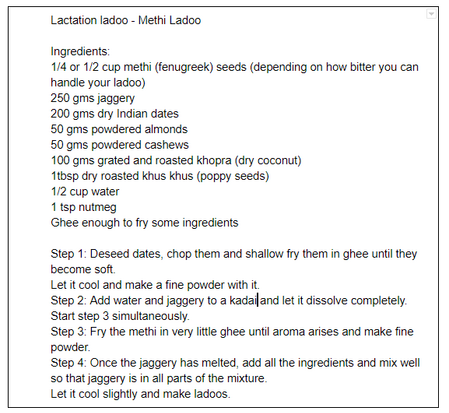
- Offering both breasts in every nursing session : When a mother is trying to build her supply, to wean the baby off formula, it makes sense to offer both breasts in each nursing session. The stimulation of both breasts results in more milk production. However, the important thing here is to do it correctly. Switching sides without efficiently draining a breast may be counterproductive. Thus, the side should be switched only after the first breast is drained completely. (Link to ‘switching sides while breastfeeding’ article)
- Perseverance : Weaning a baby off formula is tough. But dedication, constant efforts and perseverance are the keys to achieve it. Not getting discouraged by setbacks can take one a long way.
This acronym below is a guide and step by step reminder to – how to wean your baby off formula?
W – Wean gradually
E – Express and offer EBM
A – Attachment (latch)
N – Nursing vacation
I – Increase nursing frequency
N – No to bottles
G – Galactagogues (if required)
Wish to speak with a member of our team who is a certified lactation professional and also an experienced breastfeeding mother, click on this link.
Medical Advice Disclaimer
THIS WEBSITE DOES NOT PROVIDE MEDICAL ADVICE.
The information, including but not limited to, text, graphics, images and other material contained on this website are for informational purposes only. No material on this site is intended to be a substitute for professional medical advice, diagnosis or treatment. Always seek the advice of your physician or other qualified health care provider with any questions you may have regarding a medical condition or treatment before undertaking a new health care regimen, and never disregard professional medical advice or delay in seeking it because of something you have read on this website.
Disclaimer
We understand and acknowledge that parents and babies can be of various genders on a spectrum of LGBTQI+. Families come in diverse flavours. However, in our articles, for the sake of simplicity and convenience, we will be referring to the breastfeeding parent as the mother and using the female pronouns- ‘she’ and ‘her’ for babies. Babies can be nourished and nurtured in different ways and while we have used the terms breastfeeding and nursing, we recognize that parents can opt to chest feed or finger feed.
We don’t have conflicts of interest and declare, and we are compliant with the WHO code of marketing of breastmilk substitutes and the IMS act.
In case you find any information on this website that needs to be updated, please write to us at info@bsim.org.in

